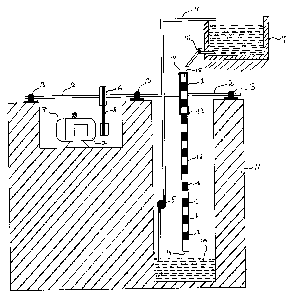Une partie des informations de ce site Web a été fournie par des sources externes. Le gouvernement du Canada n'assume aucune responsabilité concernant la précision, l'actualité ou la fiabilité des informations fournies par les sources externes. Les utilisateurs qui désirent employer cette information devraient consulter directement la source des informations. Le contenu fourni par les sources externes n'est pas assujetti aux exigences sur les langues officielles, la protection des renseignements personnels et l'accessibilité.
L'apparition de différences dans le texte et l'image des Revendications et de l'Abrégé dépend du moment auquel le document est publié. Les textes des Revendications et de l'Abrégé sont affichés :
| (12) Demande de brevet: | (11) CA 2505625 |
|---|---|
| (54) Titre français: | MOTEUR REVOLUTIONNAIRE |
| (54) Titre anglais: | REVOLUTIONARY ENGINE |
| Statut: | Réputée abandonnée et au-delà du délai pour le rétablissement - en attente de la réponse à l’avis de communication rejetée |
| (51) Classification internationale des brevets (CIB): |
|
|---|---|
| (72) Inventeurs : |
|
| (73) Titulaires : |
|
| (71) Demandeurs : |
|
| (74) Agent: | |
| (74) Co-agent: | |
| (45) Délivré: | |
| (22) Date de dépôt: | 2005-04-27 |
| (41) Mise à la disponibilité du public: | 2006-10-27 |
| Requête d'examen: | 2007-01-22 |
| Licence disponible: | S.O. |
| Cédé au domaine public: | S.O. |
| (25) Langue des documents déposés: | Anglais |
| Traité de coopération en matière de brevets (PCT): | Non |
|---|
| (30) Données de priorité de la demande: | S.O. |
|---|
A Revolutionary engine to rotate any machinery to do useful work.
A Revolutionary engine, comprising of a wheel, chain, water pump,
shaft, brackets and small containers, which are attached to the chain.
The shaft passes through the wheel and chain hangs from the wheel.
Revolutionary engine also comprising of two big containers named
as a "A" container and "B" container, "A" Container is filled with
water by the pump which pumps water from "B" container to "A"
container. "A" container is at the top of the wheel to fill the small
containers, which are attached to the chain. When the water is
allowed, from container "A" by opening the valve to fill the
containers that are attached to the chain starting from the top of
wheel as a container is filled it will move down by weight of water
and another container will take its place then second container is also
filled and it moves down. This process continues. Now when the
filled containers reach the bottom point they turn upside down and
the water from the small containers is emptied into "B" container
and small container starts moving up to get filled again and this
process continues until container "A" have the water to fill small
containers. The pump pumps water from "B" container to "A"
container. Now when all the containers that are moving down are
filled and the containers going back up are empty. The filled
containers pull the chain down by the weight of water that is in the
containers, and so they rotate the wheel that is attached to the chain.
On the other side of the shaft there is a pulley, which turns the
generator to produce electricity.
Note : Les revendications sont présentées dans la langue officielle dans laquelle elles ont été soumises.
Note : Les descriptions sont présentées dans la langue officielle dans laquelle elles ont été soumises.

2024-08-01 : Dans le cadre de la transition vers les Brevets de nouvelle génération (BNG), la base de données sur les brevets canadiens (BDBC) contient désormais un Historique d'événement plus détaillé, qui reproduit le Journal des événements de notre nouvelle solution interne.
Veuillez noter que les événements débutant par « Inactive : » se réfèrent à des événements qui ne sont plus utilisés dans notre nouvelle solution interne.
Pour une meilleure compréhension de l'état de la demande ou brevet qui figure sur cette page, la rubrique Mise en garde , et les descriptions de Brevet , Historique d'événement , Taxes périodiques et Historique des paiements devraient être consultées.
| Description | Date |
|---|---|
| Demande non rétablie avant l'échéance | 2008-04-28 |
| Le délai pour l'annulation est expiré | 2008-04-28 |
| Inactive : Demande ad hoc documentée | 2008-01-30 |
| Réputée abandonnée - omission de répondre à un avis sur les taxes pour le maintien en état | 2007-04-27 |
| Lettre envoyée | 2007-01-29 |
| Toutes les exigences pour l'examen - jugée conforme | 2007-01-22 |
| Requête d'examen reçue | 2007-01-22 |
| Exigences pour une requête d'examen - jugée conforme | 2007-01-22 |
| Demande publiée (accessible au public) | 2006-10-27 |
| Inactive : Page couverture publiée | 2006-10-26 |
| Inactive : CIB en 1re position | 2005-06-16 |
| Inactive : Certificat de dépôt - Sans RE (Anglais) | 2005-06-01 |
| Inactive : Lettre officielle | 2005-06-01 |
| Demande reçue - nationale ordinaire | 2005-06-01 |
| Date d'abandonnement | Raison | Date de rétablissement |
|---|---|---|
| 2007-04-27 |
| Type de taxes | Anniversaire | Échéance | Date payée |
|---|---|---|---|
| Taxe pour le dépôt - petite | 2005-04-27 | ||
| Requête d'examen - petite | 2007-01-22 |
Les titulaires actuels et antérieures au dossier sont affichés en ordre alphabétique.
| Titulaires actuels au dossier |
|---|
| KASHIF MUNIR CHOUDHRY |
| Titulaires antérieures au dossier |
|---|
| S.O. |